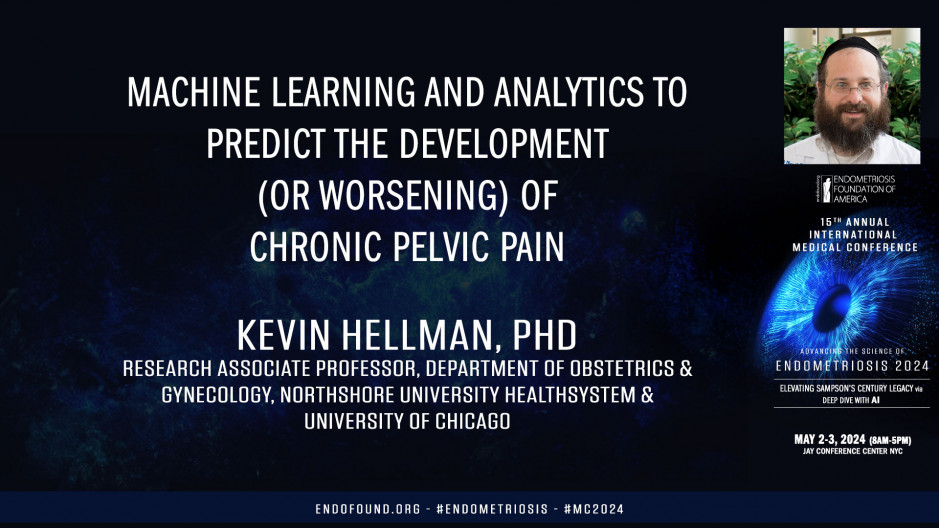International Medical Conference
Endometriosis 2024:
Elevating Sampson’s Century Legacy via
Deep Dive with AI
For the benefit of Endometriosis Foundation of America (EndoFound)
May 2-3, 2024 - JAY CENTER (Paris Room) - NYC
Good afternoon everybody. I'm going to share some data broadly about people that do not have pelvic pain that go on to develop pelvic pain. Oh, sorry, microphone and a subset. Roughly 20% of the people in these cohorts have diagnosed endometriosis. So this has broad relevance to chronic pelvic pain, and as you probably are well aware, people with endometriosis or without endometriosis that have pelvic pain have many of the same symptoms. And some of the things that I will suggest today are probably more in the realm of research in terms of what could be done in the future to predict who's going to develop worsening pelvic pain. But some of the ideas you might see as being useful when you do clinical examination, the bulk of the work, all of the work today that I'm showing you, supported by the NIHI am slated to receive some research support from Pfizer, and I will not be talking about any medical management or treatments here.
So roughly 20 years ago, there was a bit of a breakthrough in the development of our ability to predict who develops chronic pain. There was a task, it was known as diffuse noxious inhibitory controls. It's now known as condition pain modulation. And basically you measure a person's pain sensitivity, and then you have them put their hand in a bucket of ice water. And then you look to see how their pain sensitivity changes is known as endogenous pain modulation. Typically, we view it in terms of the, when you're being chased by a tiger, you don't feel pain as much. It's believed that there's this powerful descending inhibitory pathway. And I'll show you some slides that get at these mechanisms. But the bulk of the work was done initially in rodents. I'll show you the brain regions involved. There are brain regions so powerful that if you electrically stimulate them, you can produce complete analgesia.
Right now, we don't typically do that in people for a variety of reasons, but you could do a laparotomy in a rabbit if you stimulate a certain specific brainstem region. And it was believed that by doing this diffuse noxious inhibitory control pain testing, you could predict who develops chronic pain because you're essentially using sensory testing to test this pathway. And with remarkable success, they could predict yard skis, lab could predict 50% of the people that would go on to develop thoracotomy pain after surgery. And even wonder, well, why don't we have such a term tool for gynecology? There's been multiple studies that use the UK Biobank and essentially questionnaire data, electronic medical record data that goes on who predicts chronic pain. We've been focusing specifically on chronic pelvic pain and instead of using questionnaires, we use a battery of tasks. So to some extent, you would imagine if you wanted to get ACT endometriosis or pelvic pain, you'd like to look at pelvic sensitivity.
And we do that. But importantly, we look at tasks that will affect pain modulation broadly. So this is a coronal section of the brainstem. This region here is the rostral ventral medulla, I'll just abbreviate as RVM, also known as Therape Magnus. If a mouse or rat has this brain stem region lesion inactivated, the animal will not develop chronic pain. You can do something really nasty like mustard oil in its colon. You could put formal in its paw and these animals, you could create an animal model sciatica. These mice or rags will have pain for weeks to months. But if you inactivate this pain region, basically within two weeks, pain behavior goes away. And for all practical purposes, the animal looks like a normal animal. So we're still not there in people yet. Why can't we just turn on and off this brain region? I'll point out that animals still have acute pain without this brain region.
They just don't go on to develop chronic pain. It is the major source of sympathetic drive to the dorsal horn of the cord. So it likely plays an important role in modulating pain as well as if you lesion the spraying region intriguing enough, you also lose opioid analgesia about 50% of its effects. So it's clearly involved. Clearly it plays an important role in pain modulation, but unfortunately it's very hard to study in people. What we can do is study pain behavior that's likely linked to this brain region even before menses. So even before menses, you can't study menstrual pain. But we've noticed, so she'll show 'em the data today that children that have widespread body pain are more likely to have worse menstrual pain. And even if people do not have endometriosis, they're likely to develop bladder sensitivity, bowel sensitivity, and then eventually irritable bowel syndrome, which we think there is some descending modulatory mechanism that's responsible for widespread pain. And it might start off really early, and if we could reverse the process, maybe we would not see some of these symptoms of endometriosis progress into other pain syndromes.
Oh, okay. Is it going to show the data? Here we go. Alright, so what you're looking at here is we brought in kids before men are, and then we followed them up a year later. And this is, we got 300 kids, but we were able to follow up 200 of these and roughly close to a third of the kids had widespread pain before men A and on average they had quite a bit more menstrual pain within one year of men A and then two years after men A, you could see they also have significantly more widespread bodily pain. So this isn't endometriosis, this is just more menstrual pain. So whatever this widespread pain mechanism is, it existed before men are, and it predicts who is going to have sustained widespread pain. So there is some probably widespread mechanism that's responsible for increasing pain sensitivity, which includes menstrual pain in order to get at visceral pain.
People in the past used invasive tasks. This is the work of Dr. Frank to my longtime collaborator, developed this bladder sensitivity tasks where we basically ask participants to naturally drink water until their bladder is full. And we ask them to characterize how much pain they feel. And then we can also easily characterize also by ultrasound the bladder of their volumes. And what we found is you can easily screen without urodynamics people that have bladder pain syndrome, obviously they can tolerate less bladder capacity. We have people that have chronic pelvic pain that have normal capacity, but have quite a bit of pain. And we should probably get rid of the word, rid of the use of the term healthy. But people that are pain-free controls our pain-free controls have very little pain. However, if you look at people with dysmenorrhea, they hold about 100 mil less urine in their bladder at maximum tolerance, and they have quite a bit more bladder pain when their bladder is full and they perceive that as being normal roughly one in five of these participants with dysmenorrhea claim to have as much pain as what we see in our bladder pain syndrome patients.
And they see that as being normal and they have daily bladder pain, but they perceive that as being normal. We believe this is not just confined to the bladder. One of the things that we can also look at is colon tolerance. So instead of inserting something in the rectum, what we can do is we can look how much bowel gas is observed in their rectum, both on their period and off their period. When we find that there might be some myths that people with dysmenorrhea are more gassy or they have menstrual gas or menstrual pain due to their gassiness. But in fact, people with menstrual pain have less gas as measured by MRI in their colon. So we think dysmenorrhea, it's probably true with endometriosis as well. It's a condition with not just increased bodily sensitivity, but increased visceral sensitivity as well. It's a visceral sensitivity condition, which also might be a widespread pain sensitivity condition.
We've brought in people that do not have chronic pain yet they just have menstrual pain. And we can predict if people have dysmenorrhea as well as pain during our bladder task. They're three times more likely to develop irritable bowel syndrome a year later. And notably, this is controlling for psychological factors. So this is not just purely some effect of anxiety or depression or circumstances. We've used a large battery of these sensory tests with ideas. If we use more and more sensory tests, we can possibly get at these widespread neural mechanisms and ideas. If we could predict who is going to go on to develop chronic pain, we might be able to target this population in terms of either providing a more physical therapy or better surgical management. So we not only use this bladder task, we look at widespread sensitivity using pressure pain thresholds. We do repetitive pressure pain tests to look at the effect of multiple stimuli over time.
We look at this cold pressure pain, we have them put their hand in ice water. And of course, as you might expect, people are at risk to the development frame, are more likely to report that as being painful. But we also use stimuli. So we use a visual task. This was identified by the work of Dr. Dan Kla. People with fibromyalgia are more sensitive to a flashing visual checker board as well as we also look at how sensitive people are to sound as well. And we found that in general, people that have ary are more sensitive to these different tasks. But how well, if we were to take all these different data points and use that as some metric to predict who develops chronic pelvic pain, we needed to use some more sophisticated analytical methods. So one of the methods we use is principle component analysis.
And one way of trying to understand this is you can probably see all these observations are encoded by two variables, but if you rotate the axis, it's essentially encoded by a single variable. So principle component analysis is a data reduction technique. So we can essentially load all these different metrics of hypersensitivity and apply this machine learning approach to identify what factors explain the variance in the dataset. And what we notice is rather striking. You'll see that all of these are on one side of this axis. So if you do all these different tests in the large cohort of 200 people, you'll see that they're all positively correlated with each other. And this explains most of the variants in this dataset. In the field of pain research, it was believed that each one of these tests might represent some special metric. Oh, when we do the bladder tests, we're measuring how sensitive their bladder is, and we're looking at their pelvic sensitivity, we're looking at how sensitive their pelvis is.
But in reality, we're not really measuring specific neural pathways. Whenever you've bombarded someone with a bunch of these different tests, you're essentially looking at how sensitive that person is to experimental sensitivity, right? So the single most important thing to realize is our bladder test is predictive. But if we were to do more tests and look at the correlations and make a combined factor that takes all these different experimental tests into consideration, it overlaps onto a single component. I'm not going to really talk about the other components due to lack of time, but what we see is at baseline, this single component that takes into consideration all these different experimental sensitivity factors, it's correlated with pain interference. This is a spearman correlation, coefficient, pain, behavior, depression, anxiety, menal pain. These are tests for bladder pain syndrome, physical health, and just broadly somatic symptoms. But what's key here is what you might anticipate is the biggest predictor of where someone's going to be one year from now is their current level of pain.
And indeed, our model showed that. But when it comes to 2, 3, 4 years out, looking at the single factor, this combined metric of experimental sensitivity was the biggest predictor of the level of pain that people would be up to four years later. So our thought is, if you remember, Dr. Misers talked this morning, she showed that a substantial number of people with endometriosis even after surgery, continued to have sustained pain. We need to consider to some extent what would've been their natural course even without surgery. And in fact, to some extent, there might be some, I don't know whether it's a neural mechanism, although that is something that we're looking at. If we could figure out whatever that pathway is or whatever that mechanism is, and predict a person's trajectory, we might intervene differently. So this is just another way of looking at it. People that are in this 75th percentile score for this factor, they're coded in orange.
You can see they're pretty much consistently the people that have higher pain for up to four years later. We've begun. We also have brain activity, EG activity, a lot of these patients, and we're using another form of machine learning structure vector machines to predict just looking at brain activity patterns, who's likely to have maintained chronic pain. So our hope is by looking at these experimental tasks and by looking at brain activity, we might have better insight on patients' natural trajectories. And our work is also starting to suggest that to some extent, some of these mechanisms might have even emerged even before mec.
So to some extent, I largely believe that endometriosis, it's a uterine condition, but there is an important role probably for a brainstem pathway given its importance in pain modulation in animal models. And we do see that in terms of the symptoms, in terms of the pain phenotypes. It's not just localized to the bladder or to pelvic sensitivity, but widespread pain. So we need to figure out, we need to validate this in a larger data set. So we've looked at about 200 adults with all these experimental tasks and more in reduced sex. And we started to look at this at about 300 children. But we to validate this in a larger task. And we're also looking at to see whether if we look at this phenotype of experimental sensitivity, we try interventions that affect experimental sensitivity, whether it can affect outcome. Thank you.










